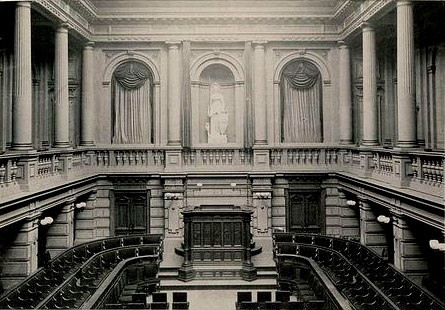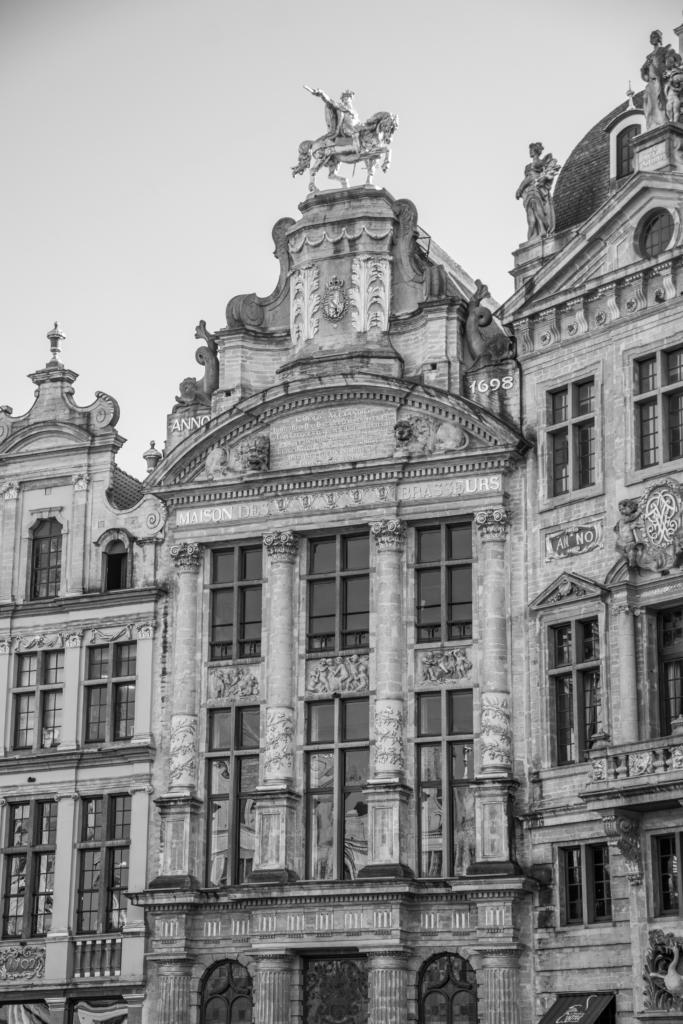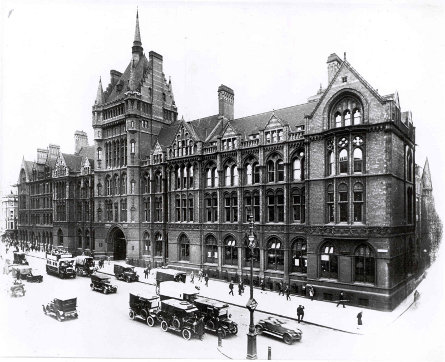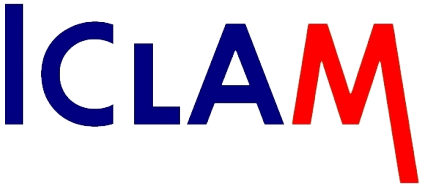History
The history of ICLAM started in 1899, when Dr. E. Poëls, Chief Medical Director of Compagnie Belge d´Assurances Générales, organized the first International Conference in Brussels. At the conference, the attendees agreed on the foundation of an international association.
AIMECA
- The buildings of the Oudemannenhuis date from 1601 and were reconstructed in Louis XV style in 1754. The Aula was constructed in 1877 and demolished in 1960. Since 1880 the complex is owned by the University of Amsterdam.
- Most of the delegates in 1899 came from Belgium and the Netherlands. So it was obvious that the Netherlands should host the second conference.
- Since Brussels in 1899, the conferences were held every 2-3 years: 1901 in Amsterdam, 1903 Paris and 1906 Berlin; but 1909 Vienna had to be canceled, as did the alternative 1910 Stockholm.
- As the Dutch national committee decided to change their statutes in January 1910 to become independent, AIMECA probably fell apart in the last months of 1909, when it became evident that a conference in 1910 would not be feasible.
- The international tensions rose, soon followed by the Great War of 1914-1918. International cooperation would be difficult for a long period.

The AIMECA conferences were held in three languages:
French
English
German
The following designations can be found in contemporary publications:
- Congrès International de Médecins Experts des Compagnies d'Assurances (1899-1906)
- International Congress of Examining Physicians for Insurance-Companies (1906)
- Internationaler Kongress für Versicherungs-Medizin (1906)
- Internationaal Congres van Levensverzekeringartsen (1899)
- Internationaal Congres van Geneesheeren van Levensverzekering-maatschappijen (1901)
Revitalization
The revitalization of AIMECA after the Great War took a very long time, till 1928. The idea was born at the 5. Internationalen Kongresses für Unfallheilkunde und Berufskrankheiten in Budapest. Noteworthy is, that the first Conference of this kind was organized in Liège from May 29th to June 1st 1905 by the same Dr. E. Poëls that founded AIMECA. The Conference President was Dr. Müller and the General-Secretary was – of course – Dr. E. Poëls.
After three years of preparation, ICLAM restarted at a special meeting during the 6. Internationalen Kongresses für Unfallheilkunde und Berufskrankheiten, held August 3rd-8th 1931 in Geneva. Present at this meeting were representatives from Germany, the Netherlands, Italy, Sweden, and Switzerland. It was decided that they would form a provisionary Bureau that would prepare the foundation of a new organization, called Permanent International Committee for the study of Life Assurance Medicine. Members of the provisionary Bureau were representatives from Belgium, France, Germany, Italy, Netherlands, Sweden, Switzerland and the United Kingdom. The German Dr. Paul Hörnig was elected President, and the Swiss Dr. Kaufmann was elected General-Secretary.
The members of the provisionary Bureau regarded the new organization as the continuation of AIMECA and invited Dr. E. Poëls to join them. But to their disappointment Dr. Poëls did not accept this invitation. A list of members of the provionary Bureau can be found at the page Names in the History of ICLAM.


First ICLAM Conference
The provisonary Bureau held its first official meeting in Brussels, September 11th 1932. In Brussels the provisonary Bureau approved the Statutes drawn by Dr. Hörnig and appointed the Permanent Committee with members from 15 countries, with a Bureau consisting of 9 members. Dr. Goffin was appointed Vice-President and was asked to organize the first conference in Brussels in 1935, preferably together with the 7. Internationalen Kongresses für Unfallheilkunde und Berufskrankheiten. In September 1933 it became clear that it would not be possible to organize the conference in Brussels, as no Organizing Committee could be established.
Cooperation with the Organizing Committee of the other Conference failed, and the Belgian doctors refused to work under the directives of an international committee, claiming AIMECA was originally a Belgian association. Dr. May offered London as an alternative and the preparations for the conference started in December 1933. The first ICLAM Conference in 29 years opened on July 23rd 1935 at Holborn Bars, the offices of Prudential Assurance Company. ICLAM was back to stay. Holborn Bars, venue of the first ICLAM Conference July 23rd 27th 1935 Picture by courtesy of Prudential Group Archives Although ICLAM was founded in 1932, the Committee claims having been founded in 1901, as ICLAM can be regarded and was meant to be the continuation of AIMECA. Thanks to a small misunderstanding ICLAM celebrated its 100 years of existence in 1999, a century after the first international conference. Atthe 25th ICLAM conference in 2016 we celebrate being 115 years old. Interesting is the fact that the Dutch GAV, founded the very same date in 1901, discovered the mix-up in time and decided to postpone their own celebrations to 2001.
21st Century
ICLAM may not have grown in numbers of delegates (300 to 500 depending on location and prices), but it has expanded over the continents.
The next ICLAM Conference will be in the Netherlands in 2016. Location, prices and the active involvement of the Dutch community suggest this will be a new success, both in number of delegates as in number of countries being represented – although the all-time record of Spain will not be easily broken.

In this century delegates come from all continents. In all ICLAM Conferences of this century together, 66 countries were represented. This number is even growing: Australia 38 countries, Italy 28, Germany 38, and Spain 50, making the 2013 Conference the most global ICLAM Conference in history.
Trivia
- The first Honorary member of ICLAM was the (re)founder Dr. Paul Hörnig from Germany. After the Second World War, Dr. Hörnig decided to lay down his Honorary membership.
- Under the direction of Dr. F. Kaufman in Zürich the acronym ICLAM was brought into existence, although the full name was Permanent International Committee for the study of Life Assurance Medicine. The name was shortened in 1970 to International Committee for Life Assurance Medicine, so that the name fitted the acronym ICLAM. In 1989 the name was expanded to International Committee for Life, Disability and Heath Assurance Medicine. Because the materials for the conference in London 1992 were already printed, the acronym couldn't be changed. In May 2006 the name was changed to International Committee for Insurance Medicine, but the acronym ICLAM still stands as it is well-known and respected.
- Over the years ICLAM, which started out as an European organization, has expanded to hold conferences on other continents in keeping with its title. After America, Asia, and Australia, Africa was the last continent missing on the list. We have enjoyed the excellent African hospitality at the ICLAM 2010, which was held in Cape Town. With Madrid in 2013 and Maastricht in 2016, the venue is back in Europe. 2019 will be the second time that we go to Asia, to Mumbai, one of the biggest cities in the world.
- The Kurhaus, Scheveningen (The Hague), the Netherlands. Venue of the sixth ICLAM Conference June 12th-14th 1958.Picture from Haags Gemeentearchief, taken around 1955.
- At the conference in Scheveningen 1958 the Conference Logo seems to have been introduced. Since that year, every conference has its own logo. For the conference in Tokyo 1986, the archives were scanned for logos of previous conferences, to show them during the conference. For the conference in The Hague 1989, the wives of the members of the ICLAM Bureau produced flags on the basis of the recollected logos and designed new flags for the first five conferences. All flags were presented in a parade during the conference.
- From 1989 to 2010, all banners were shown in the Auditorium at each ICLAM Conference. In 2012 all banners were professionally photographed. Starting 2013, the banners are shown with other means. The banners were stored with the ICLAM Archives in Switzerland in July 2013. Robert Kneepkens



Sources
- ICLAM Archives General-Secretary 1958-2009.
- Premier congrès international des médecins de compagnies d’assurances: Rapports, procès-verbaux des séances. Bruxelles 1899.1
- Deuxième congrès international des médecins de compagnies d’assurances: Rapports, procès-verbaux des séances. Bruxelles 1901.1
- Troisième congrès international des médecins de compagnies d’assurances: Rapports, procès-verbaux des séances. Paris 1903.1
- Berichte und Verhandlungen des vierten internationalen Kongresses für Versicherungs-Medizin. Berlin 1906.1
- Bulletin de l’association internationale des médecins-experts de compagnies d’assurances 1902-1904.1
- Jaarboekje voor 1900. Vereeniging voor Levensverzekering.1
- Jaarboekje voor 1902. Vereeniging voor Levensverzekering.1
- Nederlandsch Tijdschrift voor Geneeskunde, 6 februari 1909.2
- Life assurance medicine: proceedings of the 10th international conference of life assurance medicine. London 1970.2
- Annals of life insurance medicine: conference Brussels 1982.2
- Annals of life insurance medicine: conference Tokyo 1986.2
- Klasien Horstman. Verzekerd Leven. Babylon-De Geus: 1996.2
- Klasien Horstman. Public bodies private lives. Erasmus publishing: 2001.2
- Henk K. de Raadt. In: Medical Selection of Life Risks. Brackenridge RDC, Elder WJ (eds.). MacMillan Publishers Ltd.: 1992.2
- Courtesy of AMEV Library, Utrecht, Netherlands
- Collection Robert Kneepkens